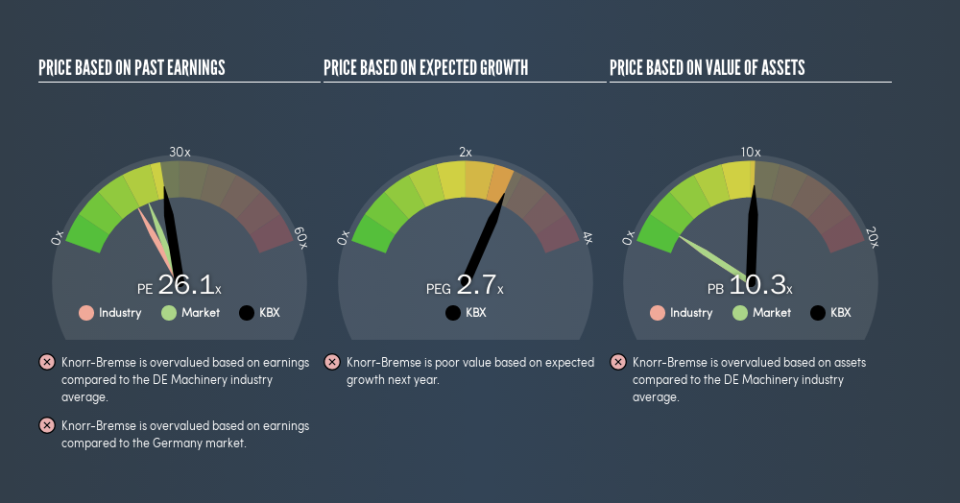Why Knorr-Bremse Aktiengesellschaft's (ETR:KBX) High P/E Ratio Isn't Necessarily A Bad Thing

Want to participate in a short research study? Help shape the future of investing tools and you could win a $250 gift card!
Today, we'll introduce the concept of the P/E ratio for those who are learning about investing. We'll look at Knorr-Bremse Aktiengesellschaft's (ETR:KBX) P/E ratio and reflect on what it tells us about the company's share price. Knorr-Bremse has a price to earnings ratio of 26.11, based on the last twelve months. That means that at current prices, buyers pay €26.11 for every €1 in trailing yearly profits.
View our latest analysis for Knorr-Bremse
How Do I Calculate Knorr-Bremse's Price To Earnings Ratio?
The formula for P/E is:
Price to Earnings Ratio = Share Price ÷ Earnings per Share (EPS)
Or for Knorr-Bremse:
P/E of 26.11 = €96 ÷ €3.68 (Based on the trailing twelve months to December 2018.)
Is A High P/E Ratio Good?
The higher the P/E ratio, the higher the price tag of a business, relative to its trailing earnings. That isn't a good or a bad thing on its own, but a high P/E means that buyers have a higher opinion of the business's prospects, relative to stocks with a lower P/E.
How Growth Rates Impact P/E Ratios
Earnings growth rates have a big influence on P/E ratios. That's because companies that grow earnings per share quickly will rapidly increase the 'E' in the equation. Therefore, even if you pay a high multiple of earnings now, that multiple will become lower in the future. So while a stock may look expensive based on past earnings, it could be cheap based on future earnings.
Most would be impressed by Knorr-Bremse earnings growth of 11% in the last year. And its annual EPS growth rate over 5 years is 13%. With that performance, you might expect an above average P/E ratio.
How Does Knorr-Bremse's P/E Ratio Compare To Its Peers?
We can get an indication of market expectations by looking at the P/E ratio. You can see in the image below that the average P/E (17.8) for companies in the machinery industry is lower than Knorr-Bremse's P/E.
That means that the market expects Knorr-Bremse will outperform other companies in its industry. Clearly the market expects growth, but it isn't guaranteed. So investors should delve deeper. I like to check if company insiders have been buying or selling.
Don't Forget: The P/E Does Not Account For Debt or Bank Deposits
Don't forget that the P/E ratio considers market capitalization. That means it doesn't take debt or cash into account. Hypothetically, a company could reduce its future P/E ratio by spending its cash (or taking on debt) to achieve higher earnings.
Such expenditure might be good or bad, in the long term, but the point here is that the balance sheet is not reflected by this ratio.
Is Debt Impacting Knorr-Bremse's P/E?
The extra options and safety that comes with Knorr-Bremse's €270m net cash position means that it deserves a higher P/E than it would if it had a lot of net debt.
The Verdict On Knorr-Bremse's P/E Ratio
Knorr-Bremse has a P/E of 26.1. That's higher than the average in the DE market, which is 20.8. With cash in the bank the company has plenty of growth options -- and it is already on the right track. So it does not seem strange that the P/E is above average.
Investors should be looking to buy stocks that the market is wrong about. People often underestimate remarkable growth -- so investors can make money when fast growth is not fully appreciated. So this free report on the analyst consensus forecasts could help you make a master move on this stock.
Of course, you might find a fantastic investment by looking at a few good candidates. So take a peek at this free list of companies with modest (or no) debt, trading on a P/E below 20.
We aim to bring you long-term focused research analysis driven by fundamental data. Note that our analysis may not factor in the latest price-sensitive company announcements or qualitative material.
If you spot an error that warrants correction, please contact the editor at editorial-team@simplywallst.com. This article by Simply Wall St is general in nature. It does not constitute a recommendation to buy or sell any stock, and does not take account of your objectives, or your financial situation. Simply Wall St has no position in the stocks mentioned. Thank you for reading.

